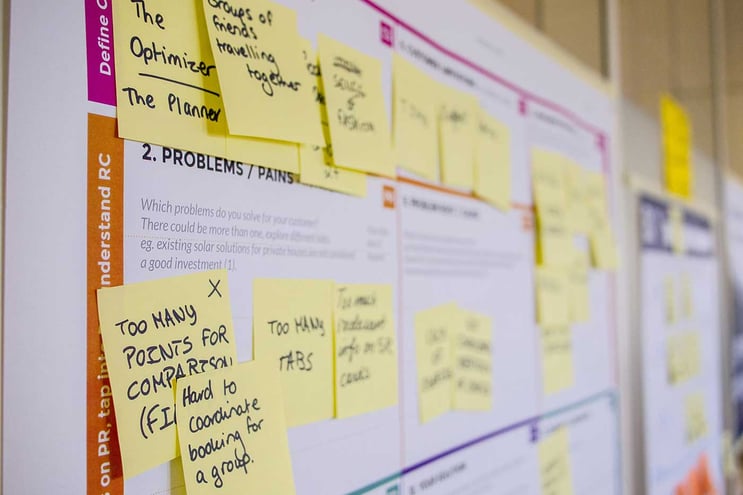Agile methodology is a flexible and collaborative approach to modern project management. It is crucial because it allows teams to adapt quickly to evolving requirements, deliver high-quality products efficiently, and engage stakeholders actively throughout the development process.

October 7, 2023
Best Practices for an Agile QA Process
Written by Katie Bielawiec
Overview


-
Agile methodology is a flexible and collaborative approach to modern project management, enabling teams to adapt quickly and engage stakeholders actively.
-
Key advantages of Agile include rapid bug detection, enhanced stakeholder engagement, and flexibility.
-
Agile finds use cases in a wide range of industries, from software development to marketing, where iterative and adaptable project approaches are beneficial.
Time to read: 20 min
Exploring Best Practices for the Agile QA Process
This article explores best practices for implementing an Agile Quality Assurance (QA) process, emphasizing its role in project success. It discusses Agile's advantages, frequent iterations, and stakeholder engagement. By aligning Agile methodologies with Digital Strategy Consulting and Digital Transformation Services, organizations can further optimize their QA processes and ensure project success.

The article delves into four phases of Agile: Planning, Execution, Continuous Improvement, and Communication & Collaboration, outlining specific best practices for each.
These include early QA process involvement, collaboration on issue identification, creating Agile tests, testing each iteration, identifying and reporting defects, resolving issues collaboratively, reviewing the QA process, incorporating stakeholder feedback, and implementing automation testing.
Effective communication and collaboration between the QA team and development teams are highlighted as essential components of Agile success during the QA process. Embracing these practices ensures efficient projects delivering high-quality results.
What is Agile?
Agile methodology, rooted in flexibility and collaboration, has become the cornerstone of modern project management. Its principles are often integrated with frameworks like the Scaled Agile Framework (SAFe) to drive large-scale Digital Transformation Services. It's renowned for enabling teams to adapt to evolving requirements and deliver high-quality products. In this article, we'll explore the intricacies of implementing best practices for an Agile QA process, emphasizing its pivotal role in project success.
"Agile is a methodology to keep clients and dev teams happy, with consistent checkpoints, client demos, and retrospectives as check-in points to make sure the project goes well."
Agile is a modern software development methodology known for its flexibility, adaptability, and customer satisfaction. Seamgen's project manager, Katie Bielawiec, aptly describes Agile as a "methodology to keep clients and dev teams happy with consistent checkpoints, client demos, and retrospectives as check-in points to ensure the project's success. If not, adjustments can be made accordingly."
In essence, Agile is a development approach that emphasizes small, frequent iterations or repetitive cycles. These iterations allow the QA team to gather feedback faster and at lower costs. The primary goal is to enable Agile teams to respond rapidly to changes in the market or the evolving preferences of stakeholders, all without discarding existing plans.
![]()
Agile is rooted in a set of foundational principles and frameworks such as Scrum, Kanban, and Lean, which provide specific guidelines and practices for implementing Agile methodologies. These principles and frameworks help teams collaborate more efficiently, improve their QA process, and deliver high-quality software products that meet or exceed stakeholder expectations.
Agile's iterative nature, combined with its principles and frameworks, makes it a powerful methodology for achieving project success.
Who are We? Agile Masters
- At Seamgen, we employ a flexible, repeatable agile software development process focused on releasing rapid iterations into test environments.
- Over a decade of experience with agile methodologies leading to optimal, successful software deliveries.
- Projects kickoff with design, development, and project management teams working collaboratively.
- USA design led San Diego custom software development company based in Southern California.
- We invite you to call us for a free project consulation.
Advantages/Disadvantages of Agile
Agile development brings several advantages to development teams and stakeholders alike. One of its strengths lies in the ability to detect and resolve bugs through frequent iterations. This iterative approach allows Agile teams to respond to changes in requirements or emerging issues.
However, it's essential to recognize that Agile isn't without its challenges, but these challenges can be effectively managed or mitigated.
- Enhanced Stakeholder Satisfaction and Engagement
- Efficient Resource Utilization
- Active Stakeholder Participation
- Early Bug Detection
- Requires a Cultural Shift
- Challenges in Budgeting
- Potential for Scope Creep
- Resource Reallocation
- Less Predictability
Advantages
Enhanced Stakeholder Satisfaction and Engagement: Agile methodologies' iterative cycles offer stakeholders, including clients, end-users, and investors, a unique level of involvement from the project's inception. They receive regular updates and witness the project's evolution, fostering transparency, trust, and a sense of shared ownership. This heightened engagement contributes to a more successful QA process and project outcome.

Efficient Resource Utilization: Agile QA allows for dynamic allocation and reallocation of resources based on the immediate needs of the project.
Active Stakeholder Participation: Stakeholders play a pivotal role in Agile development, contributing not only to defining project goals but also shaping its evolution. This early, ongoing involvement ensures a clear, shared vision from the outset, which is adjustable as the project progresses. This alignment fosters a harmonious and productive environment conducive to innovation and excellence.
Early Bug Detection: Regular and frequent testing means defects are identified earlier, reducing the cost and time to resolve them.
Disadvantages
Requires a Cultural Shift: Traditional teams may find it challenging to adapt to the Agile mindset, which can cause resistance and friction.
Challenges in Budgeting: Agile's iterative nature can pose challenges for precise budgeting. The fluidity of the process makes it challenging to estimate the exact cost of the project accurately. However, this challenge can be managed by adopting flexible budgeting approaches open to changes and updates throughout the development cycle.
Potential for Scope Creep: Without strong product ownership and clear acceptance criteria, there's a potential for scope creep, where features or requirements keep getting added.
Resource Reallocation: While Agile's flexibility is beneficial, it also requires the seamless reallocation of resources as needed. This can be seen as a potential disadvantage, but it aligns with the Agile principle of responsiveness to stakeholder feedback. Effective resource management and planning mitigates this challenge, ensuring the project remains adaptable and responsive throughout the development process.
Less Predictability: The dynamic nature of Agile can sometimes make it harder to predict exact delivery dates or the final scope of a project, especially early on.
In summary, the Agile methodologies' advantages, including increased stakeholder satisfaction and active participation, significantly outweigh its disadvantages when managed effectively. Challenges related to budgeting and resource reallocation can be addressed by adopting an Agile-friendly financial and resource management strategy, as well as a QA process.
This makes Agile an inclusive and adaptable approach that promotes successful project outcomes while accommodating evolving stakeholder needs.
Seamgen Pro Tip: At Seamgen, we've honed a repeatable and flexible agile-hybrid software development process. We prioritize quick, iterative releases into test environments, ensuring that web and mobile application services are built ahead of UI/UX development. This approach feeds back into design and maintains constant stakeholder visibility.

Katie Bielawiec
Senior Project Manager, Seamgen
Katie, our Senior Project Manager at Seamgen, is a dedicated professional with a robust foundation from the University of California, San Diego (UCSD). With experience spanning diverse roles and industries, from Achieve Internet to leading digital initiatives at Seamgen, she has a proven track record of steering successful projects and showcasing unparalleled expertise in the realm of project management.
Driving Your Project to Success
Agile Process Phases
Now that we've laid the groundwork by discussing the Agile methodology and its pros and cons, it's time to delve into the nitty-gritty. If Agile is the vehicle driving your project to success, think of the various Agile phases as the gears that make the ride smooth and efficient.

Each phase has its own best practices, particularly for quality assurance (QA), which involves testing and ensuring the quality of the software. That maximizes efficiency, minimizes errors, and ensures the development team, qa team, and stakeholders remain in harmony. Let's shift our focus to these phases, starting with Planning, and explore how to optimize your Agile QA process at each stage.
01
Planning
02
Execution
03
Continuous Improvement
04
Communication & Collaboration
Phase #1: Planning
Involve QA Early
Early involvement of QA teams in project planning is indispensable. Beyond simply identifying and addressing issues, this collaborative phase allows QA process experts to influence the project's direction. They offer insights into software testing strategies, assess proposed solutions' feasibility, and evaluate potential risks. By aligning quality assurance with project goals, early QA team engagement sets the foundation for a cohesive development process.
Collaborate on Issue Identification
Effective collaboration between development and QA teams during the planning phase is paramount to any agile methodologies. It's not just about identifying issues but assessing their impact and devising proactive mitigation strategies. This collaborative approach enhances risk management, which involves identifying and mitigating potential challenges or issues that could affect the project. By anticipating and addressing challenges before they escalate, risk management saves time and resources while fostering an environment of shared responsibility and a proactive QA process.

Create Agile Test Cases
Creating Agile-specific test cases is more than just a checklist; it's a process tailored to the iterative nature of Agile projects. Test cases are detailed documentation outlining specific scenarios and conditions under which the software gets tested. Agile testing cases evolve with the project, adapting to changing priorities and requirements. Agile test cases must be nimble and comprehensive, enabling QA teams to respond swiftly to new features and modifications. Their flexibility ensures that testing remains aligned with the project's fluid development path.
01
Planning
02
Execution
03
Continuous Improvement
04
Communication & Collaboration
Phase #2: Execution
Test Each Iteration
Testing each iteration is at the heart of an Agile development approach. This practice ensures that product quality is maintained, errors are identified promptly, and the software functions as intended. Iteration-based agile testing serves as a constant feedback loop, guiding improvements and reinforcing confidence in the evolving product. Its meticulous nature fosters a culture of continuous improvement, promoting a better end product.

Identify and Report Defects
Establishing a systematic process for identifying and reporting defects is essential for maintaining product reliability. Robust defect identification involves not only finding issues but also documenting them meticulously and communicating them effectively to relevant stakeholders. Timely reporting ensures that development teams can address issues promptly, streamlining the QA process, increasing customer satisfaction, and mitigating the accumulation of costly rework.
Collaborate for Issue Resolution
Collaboration between development and QA teams doesn't end at the planning phase; it's a continual effort throughout the execution phase. Effective communication, shared responsibilities, and a unified vision are crucial elements of issue resolution. A collaborative approach to testing activities taps into the expertise of both teams, leading to innovative solutions and expedited problem-solving. This continuous collaboration ensures that the project remains adaptable and resilient.
01
Planning
02
Execution
03
Continuous Improvement
04
Communication & Collaboration
Phase #3: Continuous Improvement
Regularly Review QA Process
Consistently evaluating and enhancing the QA process is vital for its effectiveness. Periodic reviews assess the efficiency of software testing methodologies, tools, and procedures. This continuous improvement loop ensures that QA practices stay aligned with Agile principles, enhancing the overall quality of the project. Regular reviews are a proactive measure to identify and address potential bottlenecks and inefficiencies in the qa testing process.
Seamgen Pro Tip: Robust Quality Assurance (QA) is a cornerstone of Seamgen's approach. We ensure that all project requirements are built correctly, and our QA process team establishes User Acceptance Testing (UAT) automation to prevent future concerns.
Incorporate Stakeholder Feedback
Stakeholder feedback is a goldmine of insights into user expectations and market dynamics. Actively seeking and incorporating this feedback allows organizations to tailor their products to evolving needs. By doing so, organizations foster customer satisfaction, build stronger relationships, and create products that resonate with their audience. This feedback-driven approach is a competitive advantage that promotes long-term success.

Implement Automation Testing
Leveraging automation testing tools and frameworks is a strategic choice for Agile QA practices. Automation significantly enhances software testing efficiency, reduces human error, and ensures consistent agile testing results. It's particularly valuable for repetitive and time-consuming tasks, allowing QA teams to allocate their resources to more complex and critical testing activities. The result is faster, more reliable testing, and a higher-quality end product.
01
Planning
02
Execution
03
Continuous Improvement
04
Communication & Collaboration
Phase #4: Communication and Collaboration
Prioritize Team Communication
Effective communication between QA and development teams is the linchpin of Agile development success. Daily stand-up meetings, frequent status updates, and open channels of communication ensure that everyone remains informed and aligned. Transparent communication minimizes misunderstandings, supports rapid decision-making, and facilitates monitoring of the QA process.
Seamgen Pro Tip: Seamgen's agile approach encompasses both short-term and long-term plans, ensuring a quality end-to-end software development process. The design team works closely with the dev team to create flexible and unique design systems that adapt to multiple devices.
Hold Regular Meetings
Scheduled meetings and updates, when conducted with a clear agenda and objectives, promote accountability, transparency, and timely interventions. Here at Seamgen, we typically hold two weekly meetings with stakeholders. These meetings provide a structured platform for discussing project status, addressing challenges, and adapting to changes. By adhering to regular meetings, teams can proactively manage risks, streamline the qa testing process, and ensure the project remains on track.
Foster Collaboration and Teamwork
Collaboration extends beyond communication; it's the cornerstone of teamwork. By fostering a culture of shared ownership and mutual support, organizations maximize their efficiency and adaptability. Software development teams working cohesively are better equipped to overcome challenges and innovate in response to evolving requirements. Prioritizing collaboration and teamwork promotes a unified project approach and empowers teams to deliver their best work.
Incorporating these comprehensive best practices into your Agile QA process ensures that your projects are not only efficient but also consistently deliver high-quality results that meet and exceed stakeholder expectations.
FREQUENTLY ASKED QUESTIONS
2
How does Agile handle challenges like budgeting and resource reallocation?
+
Agile's flexibility can pose challenges in precise budgeting, but these challenges can be managed by adopting flexible budgeting approaches that accommodate changes. Resource reallocation is a part of Agile development responsiveness to stakeholder feedback, which can be managed through resource planning, management strategies, and the QA process.
3
What are the key advantages of Agile development for both development teams and stakeholders?
+
Agile offers advantages such as rapid bug detection, enhanced stakeholder engagement, and flexibility. Stakeholders actively participate from the project's start, fostering trust and shared vision. This way, dev teams tailor the QA process to stakeholder needs.
4
Why is early involvement of QA teams important in Agile project planning?
+
Early QA involvement is crucial because it allows QA experts to influence the project's direction, provide insights into testing strategies, assess the feasibility of solutions, and evaluate potential risks. This sets the foundation for a well-planned development process.
5
How can organizations consistently deliver high-quality results in Agile projects?
+
Organizations can consistently deliver high-quality results in Agile projects by embracing best practices such as early QA involvement, collaborative issue identification, Agile-specific test case creation, an iterative testing process, effective defect identification and reporting, collaborative issue resolution, regular QA process reviews, stakeholder feedback incorporation, and automation testing. These practices ensure that teams remain efficient and responsive to changing requirements, meeting or exceeding stakeholder expectations.
Wrapping Up
In summary, we've explored Agile methodology, known for its flexibility and collaboration, which has become integral to the modern development process. Agile's core principles emphasize checkpoints, demos, and retrospectives to ensure project success and stakeholder satisfaction. Its iterative approach offers rapid bug detection, stakeholder engagement, and adaptability.
We've covered the four key Agile phases—Planning, Execution, Continuous Improvement, and Communication & Collaboration—with best practices like early quality assurance involvement, collaborative issue resolution, Agile-specific test cases, iterative testing, defect reporting, process reviews, stakeholder feedback integration, and automation testing.
Effective QA and development team collaboration remains essential for Agile's success, driving efficiency and high-quality results. By embracing these Agile practices, you can confidently navigate modern project management complexities and achieve success.

Written by
Katie Bielawiec
Senior Project Manager, Seamgen
I love agile processes!

Do you need a premier custom software development partner?
Let’s discuss your modernization strategy and digital application goals.
Let's Connect
Up Next






